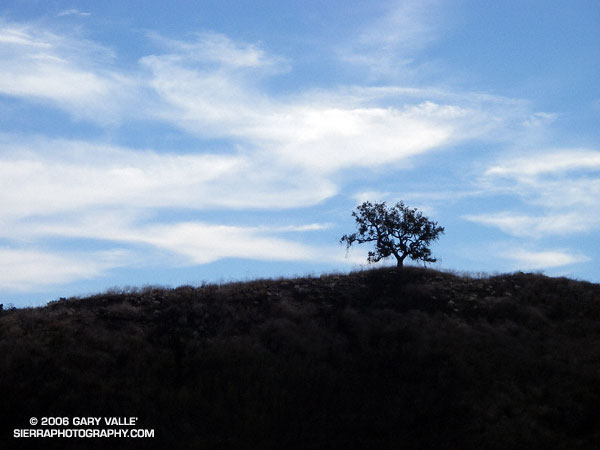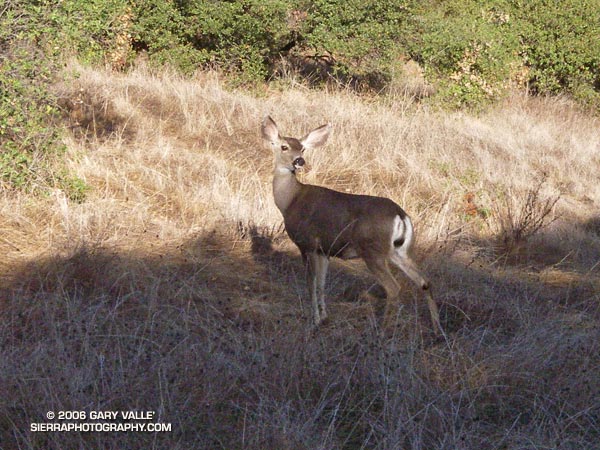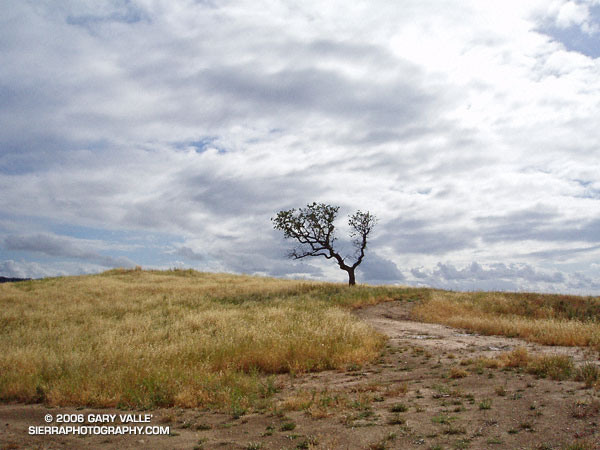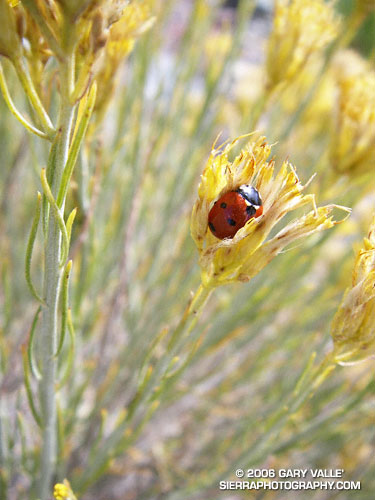
Chaparral Mallow (Malacothamnus fasciculatus) from a run at Sage Ranch Park on November 2, 2006.

Chaparral Mallow (Malacothamnus fasciculatus) from a run at Sage Ranch Park on November 2, 2006.

On the South Fork American River is a tree high on a ridge that rafters and kayakers refer to as the Lollipop Tree. It marks the beginning of the Gorge run and the class III rapid “Fowler’s Rock.”
When I run on the “main drag” at Ahmanson Ranch (Upper Las Virgenes Open Space Preserve) there is an oak tree that sits on a hilltop near Laskey Mesa that reminds me of the S.F. American tree. The Ahmanson lollipop tree can be seen on the skyline south of the main drag about a mile from the Victory trailhead.
This photograph was taken on an exploratory out and back run to the headwaters of Las Virgenes Creek on Christmas Eve.
Note: Jon Sutherland nicknamed the main road that connects the Victory trailhead to Las Virgenes Canyon the “main drag.” Jon has run out at Ahmanson for more than 30 years. He is second on the Running Streak List for most consecutive days run. As of September 1, 2006 his streak was 13,613 consecutive days (37 years 99 days), and still counting!

Glistening in the morning sun, the wet trunk of a manzanita glows in iridescent shades of orange and red, pink and purple. Decorated with raindrops, the chaparral, and all within, breathe a deep sigh of relief. It has rained!
Prior to Saturday night’s storm Los Angeles had recorded only 0.5 inch of rain in the last six months. Even by Southern California’s arid standards, this is a meager amount.
Usually when there’s an El Niño, wet Winter weather can be expected to develop in Southern California. But this year’s El Niño has been a little quirky, developing later than usual, and becoming stronger than expected. So far this Autumn, the weather here has been somewhat quirky as well, with record setting high temperatures and below average rainfall. An El Niño, even a strong one, does not guarantee wet weather in our area. Whether or not the usual El Niño impacts eventually develop, we’ll just have to see.
Another system is expected to produce some rain in Southern California this weekend, but in the last couple of days the computer weather models have been backing off the rainfall amounts. This morning’s computer-based precipitation forecasts are nearly dry. Given the difficulty the models have had with this system, and the long fetch of moisture over the Pacific, maybe the forecast will change. For additional info about the El Niño and Southern California weather, check out my Southern California Weathernotes web site.
The manzanita photograph is from the Reseda to Trippet Ranch run described in my previous post, Musch Trail Mule Deer.

About ten feet in front of me, there was a flash of brown as a large animal leaped across the trail. In the balloon of time that accompanies a surge of adrenalin, I thought of the possibilities. The last time an animal startled me, I was running on a dirt road through ten foot tall chaparral in the Simi Hills. In that case a large bob cat had bolted from the brush.
Lingering in my mind was a trail runner’s recent encounter with a mountain lion while running at Whiting Ranch in Orange County. The last place I had seen mountain lion tracks was on a muddy nature trail, not far from where I was now. That was more than a year ago. It had rained overnight, but so far I had only seen tracks of coyote, dogs and deer.
Today, I was on the Musch Trail, doing one of my favorite cool weather runs — an approximately 12.2 mile, fire roads out, trails back course from the end of Reseda Blvd. to Trippet Ranch, in Topanga State Park.
As time warped back to normal, I saw the animal wasn’t a bob cat or mountain lion, it was a mule deer. A doe had stopped just a few feet from the trail. That was unusual. Also, it was strange that her full attention wasn’t on me. Instead, she seemed concerned about something behind her, uphill from the trail. I stood quietly and watched.
She appeared to be evaluating the situation, and after about 15 seconds seemed to calm. Still alert, another 15 seconds passed, and following some unseen cue, a six or seven month old fawn was suddenly at her side.
Now her big ears, and more of her attention, were focused on me. With the fawn at her side, she obviously didn’t like being out in the open. She scented the ground, checked her fawn, and then looked back up the hill. I couldn’t see any more deer from my position, but they could easily be hidden in the surrounding cover. Almost a minute and a half after the encounter began, the doe and fawn moved into the brush.
Slowly moving a few feet along the trail, I glanced up the hill and discovered two more members of the group, waiting for me to pass. I continued walking down the trail, and after few yards, picked up the pace, and resumed my run.
Here’s a Google Earth image and Google Earth KMZ file of a GPS trace of the route.
Related posts: Christmas Berry, Mountain Lion Saga, Ferns Along the Garapito Trail.

The Chumash and Hummingbird trails are popular trails in the eastern Simi Valley, north of the 118 Freeway. These trails ascend the steep western flank of the Santa Susana Mountains to Rocky Peak fireroad. A scenic loop can be created using these trails and a connection between the Chumash and Hummingbird trailheads down in the valley. There are a few ways to do this, and the loop has proved popular.
The Chumash trailhead is on Flanagan Dr., off of Yosemite, and the Hummingbird trailhead is on Kuehner Dr. just north of the 118 Frwy. Currently, no official trail connects these trailheads. To connect them via city streets (Yosemite, E. Los Angeles Ave., Kuehner) is a long detour on pavement and doesn’t make sense from a trail-running or hiking point of view.
For many years a more direct, unofficial route has been used to connect the two trailheads. Most of the route is on dirt roads through undeveloped property. Using this route the length of the Chumash-Hummingbird loop works out to about 9.2 miles with about 1700′ of elevation gain. It’s an excellent hike, run or ride with great scenery and views.
For a number of years access to the Hummingbird Trail from Kuehner Dr. has been across property that is now being developed. A chain link fence has been in place along Kuehner for some time. Apparently, at the north end of this chain link fence there is a conservation easement that allows access to the Hummingbird Trail via a corridor adjacent to the (private) Hummingbird Ranch property. It was necessary to use this access easement when I ran this loop last weekend.
The property on the west side of Kuehner is also being developed. As I understand it, Mt. Sinai Dr. will eventually connect to Kuehner and a small parking lot will be built for trail users. Hopefully, some provision will also be made to officially connect the Chumash and Hummingbird trailheads and preserve this scenic loop.
The photograph of the oak is from a run of the loop on April 28, 2005.
Update 12/26/06 – Mike Kuhn, the director of the Rancho Simi Trailblazers, sent me the following information regarding the Hummingbird trail easement:
“At the top of Kuehner Drive is a cul-de-sac at the gate to the Hummingbird’s Nest Ranch. The white plastic fence marks the boundary of the ranch. There is a corridor of land owned by the park district along the white plastic fence down to the creek and hence to the usual crossing of the creek.”
He also said that a trail connection between Chumash and Hummingbird is in the planning stages, and encourages all trail users to be patient while the construction at Kuehner is underway.
Related post: Lower Stagecoach – Hummingbird Loop

On a chilly October morning, following a cold night at 9400 ft., a Seven-spotted Lady Beetle is slow to move from her bivouac amid the blossoms of a Rabbitbrush.
The photo is from the North Backbone Trail Revisited hike and run.